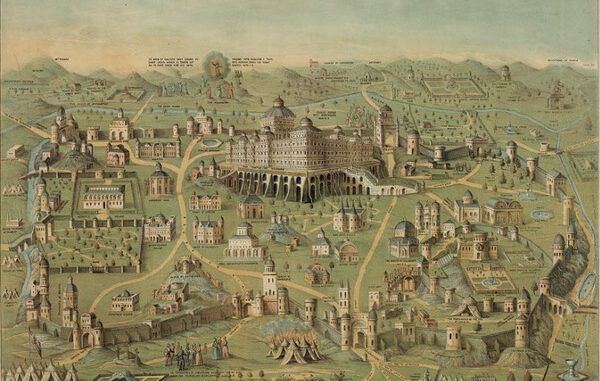
Image: The ancient city of Jerusalem with Solomon’s Temple. Library of Congress collection.
My father gave me Werner Keller’s The Bible as History when I was a kid. I’ve been a sucker for Biblical histories since then. Keller’s been superseded, both by the deconstructionists who claim the Bible isn’t true and by modern archeology, which has added to and reinterpreted many archeological findings since Keller’s time. And last week, in Jerusalem, an archeologist discovered an earring that helps confirms one of the most pivotal stories in the Bible: The destruction of Solomon’s Temple and the Babylonian captivity.
The Bible describes how the Kingdom of Judah, under Jehoiakim, refused to pay tribute to King Nebuchadnezzar of Babylon. The Babylonians besieged Jerusalem, Judah’s capital, ultimately destroying Solomon’s Temple – one of the greatest tragedies in Jewish history. Jews still mourn that destruction on Tish B’Av, which is one of the holiest days on the Jewish calendar.
Over the next twenty years or so, the Babylonians depopulated most of Judah, bringing the Jews to Babylon. All of this took place from around 605 B.C. to 580 B.C.
While the event was a tragedy, it also consolidated the identity of the Jewish people. Historically, when a nation was defeated in war, with the survivors deported to the victor’s kingdom, that nation vanished from history. That didn’t happen with the Jews. Because their God wasn’t tied to graven images and temples, He traveled with them and helped them maintain their distinct Jewish identity, right up until the Persian king, Cyrus, conquered Babylon and allowed the Jews to return home.
The Babylonian captivity gave us one beautiful psalm and one amazing story (a story I wish the Democrats would heed). Psalm 137 is lovely despite that gruesome last line:![]()
By the rivers of Babylon, there we sat down, yea, we wept, when we remembered Zion.
We hanged our harps upon the willows in the midst thereof.
For there they that carried us away captive required of us a song; and they that wasted us required of us mirth, saying, Sing us one of the songs of Zion.
How shall we sing the LORD’S song in a strange land?
If I forget thee, O Jerusalem, let my right hand forget her cunning.
If I do not remember thee, let my tongue cleave to the roof of my mouth; if I prefer not Jerusalem above my chief joy.
Remember, O LORD, the children of Edom in the day of Jerusalem; who said, Rase it, rase it, even to the foundation thereof.
O daughter of Babylon, who art to be destroyed; happy shall he be, that rewardeth thee as thou hast served us.
Happy shall he be, that taketh and dasheth thy little ones against the stones.
As for the story, in Daniel, we learn how King Belshazzar partied, even as the Persians were headed his way. At that party, a giant hand appeared and wrote on the wall: “Mene, Mene tekel upharsin.” The King’s days were numbered. The events of the past week might be sending that same message to Biden & Co.
The question is, did that Babylonian conquest and exile really happen? Based on a dazzling find in Jerusalem, yes, it did:
Archaeologists from the University of North Carolina made a remarkable discovery while digging on Mount Zion in Jerusalem that is evidence of the Babylonian conquest of the city in 586 BCE: a golden earring.
Dr. Rafi Lewis, co-director of the project, explained the importance of the tiny earring.
“With finds like this, there is a material value but, more importantly, there is a spiritual and emotional value,” Dr. Lewis told Breaking Israel News. “On that level, this find is quite literally priceless. We can establish the context as the destruction of the First Temple without any doubt. We have made similar finds outside of the city but this is the first time we made such finds inside the city.”
[snip]
“This is not proof of the destruction of the Temple since the dig is on Mount Zion, some distance from the Temple Mount,” Lewis said, noting that there has been no archaeological work permitted on the Temple Mount due to the political and religious sensitivity. “But this is certainly proof of the destruction of Jerusalem [in the Babylonian captivity time period].”
Reading that, I harked back to what Keller wrote in the introduction to his book: “You see, the Bible is right after all!”
By the way, if you’re interested in whether the Exodus really happened, I highly recommend Patterns of History: Exodus, which makes a very credible archeological argument that the Exodus happened as the Bible describes. I also recommend Dennis Prager’s Rational Bible books, especially the one about Exodus.



“The Bible is right after all!” Checking the last 100 years of archeology AND geology AND cosmology. The more we know the more the direction the Bible points is found to be true. Remembering it is NOT a book on quantum mechanics, relativity, continental drift, or virology, but where it touches on such things we are finding the comments are appropriate.